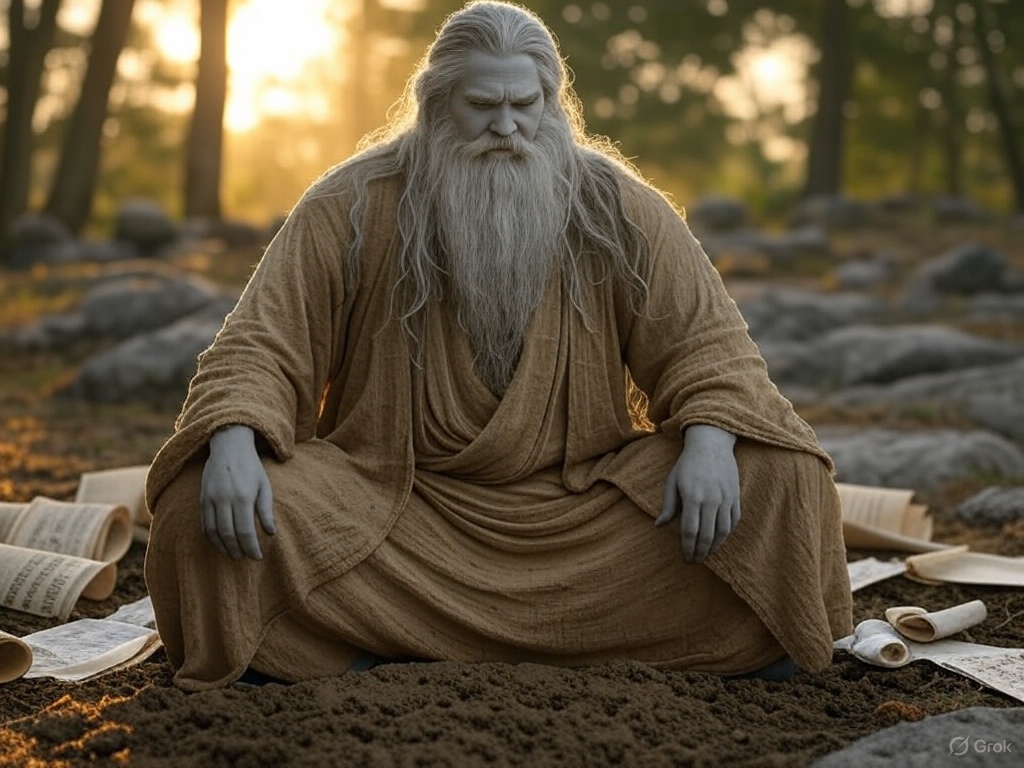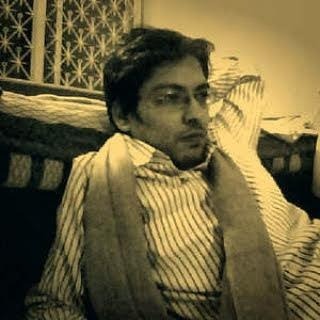Picture this: Yudhishthira, the righteous king stripped of his dominion, sits heavy-hearted on the cold earth of the forest. The weight of exile presses down, a kingdom lost to the dice, a life uprooted. Into this tableau steps Shaunaka, a Brahmin not of empty rituals or hollow chants, but a sage ablaze with the clarity of Samkhya and the discipline of Yoga. His words cut through the gloom like a blade of light (the whole section is not furnished above), not with platitudes, but with a vision of reality so profound it demands we rethink everything we’ve been told about the Mahabharata—and the Vedas themselves.
This moment in the Vanaparva is no mere anecdote. It’s a clarion call, a revelation of the true siddhanta—the foundational doctrine—that courses through the veins of the epic. Medieval Vedanta, with its ornate commentaries and monistic flourishes, would have us believe it holds the keys to the Vedic kingdom. But here, in the raw wilderness of exile, the Mahabharata whispers its secret: Samkhya and Yoga are not peripheral philosophies, not secondary footnotes to be glossed over as “Jnana Yoga” or vague mysticism. They are the soul of the text.
Shaunaka doesn’t console Yudhishthira with promises of a reunited Atman dissolving into Brahman, as the later Advaita schools might. No, he invokes a framework far more ancient, far more visceral: the Samkhya of tattvas, of Purusha and Prakriti, and the Yoga that weds discipline to discernment. “Thousands of reasons to mourn, hundreds of causes for fear,” he says, “assail the fool, but never the wise.” This isn’t a call to deny emotion or transcend the world in some ethereal escape. It’s a summons to see—to pierce the veil of Prakriti’s dance, to stand as Purusha, the untainted witness, and master the chaos through the clarity of Samkhya and the strength of Yoga.
This potency shines even brighter when we turn to the Gita itself. Early in the dialogue (2.11), Krishna confronts Arjuna’s despair with a razor-sharp truth:
श्रीभगवानुवाच |
अशोच्यानन्वशोचस्त्वं प्रज्ञावादांश्च भाषसे |
गतासूनगतासूंश्च नानुशोचन्ति पण्डिता: || 11||
“You grieve for those not worthy of grief, yet cloak it in words of wisdom. The wise lament neither for the dead nor the living.”
Compare this to Shaunaka’s counsel—both sages, sing the same hymn of the “pandita,” the wise one untouched by Prakriti’s illusions. Shaunaka’s “fools” are besieged by fear and sorrow, while his “wise” stand apart; Krishna’s “wise” see beyond life and death, rooted in Samkhya’s discernment of the eternal Purusha.
This isn’t coincidence—it’s continuity, a thread of Samkhya-Yoga wisdom stitching the Mahabharata together, from Vanaparva to Kurukshetra. And in Chapter 10 (10.26), Krishna seals it:
गन्धर्वाणां चित्ररथ: सिद्धानां कपिलो मुनि: || 26||
“Among the perfected, I am Kapila the sage.”
Kapila—the progenitor of Samkhya—crowned as the apex of siddhas, not by chance, but by divine decree. If Samkhya were mere “Jnana Yoga,” why exalt its progenitor so boldly?
Let’s be clear: Samkhya in the Mahabharata—and indeed in the Gita—is not some watered-down “knowledge yoga” squeezed into a Vedantic box. It’s Samkhya proper, the system of enumeration that maps reality into its twenty-five principles: the five elements, the senses, the mind, the intellect, and the eternal duality of Purusha (consciousness) and Prakriti (nature). The Gita’s brilliance lies not in sidelining this, but in amplifying it—Krishna’s discourse to Arjuna is drenched in Samkhya’s analytical rigor, paired with Yoga’s practical mastery. When Krishna speaks of “Sankhya” in Chapter 2, he’s not peddling a generic “path of knowledge.” He’s laying bare the architecture of existence—Prakriti’s gunas in flux, Purusha’s stillness beyond—and urging Arjuna to act from that unshakable center.
The Mahabharata’s timeless symphony swells with such coherence that it remains consistent throughout, even centuries apart.
On the Kurukshetra, Shri Krishna, elaborating on the principles of Samkhya and Yoga says:
त्रैगुण्यविषया वेदा निस्त्रैगुण्यो भवार्जुन |
निर्द्वन्द्वो नित्यसत्त्वस्थो निर्योगक्षेम आत्मवान् || 45||
The Vedas deal with the three gunas, but rise beyond them, O Arjuna. Free from dualities, rooted in eternal truth, unconcerned with gain or loss, abide as the self.
ज्ञेय: स नित्यसंन्यासी यो न द्वेष्टि न काङ् क्षति |
निर्द्वन्द्वो हि महाबाहो सुखं बन्धात्प्रमुच्यते || 3||
Know him as the eternal renunciate who neither hates nor craves.
Beyond dualities, O mighty-armed one, he finds bliss and liberation from bondage.
Generations earlier, Yayati, the progenitor of the Yadavas, in the twilight of his rule, casts aside his burdens, proclaiming:
तस्मादेतन्महं त्यक्त्वा ब्रह्मण्याधाय मानसम्।
निर्द्वन्द्वो निर्ममो भूत्वा चारिष्यामि मृगेः सह॥१६॥
I will anchor my mind in Brahma, free from dualities and possessions, wandering amongst the deer.
Later still, Pandu, poised for his forest retreat, vows with unwavering resolve:
न शोकं न प्रहर्षं तुल्यनिन्दात्मसंस्तुतिः।
निराशिर्निर्ममोऽकारो निर्द्वन्द्वो निष्परिग्रहः॥
Neither sorrow nor joy, equal in praise or blame,
Free from desire, detached, selfless, beyond dualities, grasping at nothing. (I shall even live)
From Yayati’s renunciation to Pandu’s ascetic pledge, to Arjuna’s call to arms, a single refrain echoes: go beyond dualities (निर्द्वन्द्व), the tug of opposites. Far from a modern reinterpretation, this is the ancient Samkhya-Yoga, the golden thread stitched deep into the Mahabharata’s Vedic heart.
The Shanti Parva echoes this truth louder still. Bhishma, on his bed of arrows, doesn’t drone on about merging into an abstract oneness. He unfolds Samkhya’s cosmology and Yoga’s path with the precision of a warrior wielding his blade—teaching Yudhishthira how to rule not just a kingdom, but the self. This is the Mahabharata’s heartbeat: a tattva (principle) that doesn’t flee the world, but engages it, dissects it, and triumphs over it.
And yet, this pristine vision faced a formidable adversary millenia later—none other than Shankaracharya, the titan of Advaita Vedanta. In his Brahmasutra Bhashya (2.1.1), he famously dubs Samkhya the “prathama malla”—the “foremost wrestler” or primary opponent—acknowledging its intellectual might even as he seeks to topple it. He writes, “सांख्यं हि सर्वं विश्वं प्रकृतिपुरुषविवेकेन व्याचष्टे” (“Samkhya indeed explains the entire universe through the distinction of Prakriti and Purusha”), only to argue that this duality falters against his non-dual Brahman. Shankaracharya’s feud wasn’t with a strawman—he knew Samkhya’s strength, its deep Vedic roots, and its grip on texts like the Mahabharata. His critique betrays a tension: Samkhya’s vivid duality and Yoga’s disciplined praxis were too potent, too alive, to be easily subsumed into Advaita’s seamless unity.
Contrast this with the medieval Vedanta schools—often retrospective, layering their own gloss over the raw vitality of the earlier systems. Advaita’s non-dualism flattens the dynamic tension of Purusha and Prakriti into a singular Brahman, sidelining the lived duality that Samkhya honors. The Mahabharata doesn’t preach dissolution; it demands confrontation—between dharma and adharma, spirit and matter, the self and the not-self. Samkhya and Yoga equip the Pandavas for this, not by erasing the battlefield, but by illuminating it.
Shaunaka’s words to Yudhishthira are a microcosm of this vision. The Brahmin doesn’t deny the king’s grief—he contextualizes it. Pain, fear, loss—these are Prakriti’s waves, inevitable in the flux of the gunas. But the wise, armed with Samkhya’s discernment and Yoga’s steady breath, rise above. This isn’t escapism; it’s empowerment. The Pandavas’ exile isn’t just a physical journey—it’s a metaphysical forge, tempering them in the fires of these ancient truths.
So let’s shake off the dust of centuries. The Mahabharata isn’t a relic of Vedanta’s making—it’s a living testament to Samkhya and Yoga as the Vedic siddhanta par excellence. These are not mere terms sprinkled across the Gita or Shanti Parva; they are the epic’s lifeblood, its adhyatmic spine. To read them otherwise—to reduce Samkhya to “Jnana” or Yoga to mere meditation—is to miss the forest for the trees. The Vedas sang of a cosmos alive with duality and discipline long before the medieval schools wove their intricate webs. The Mahabharata, in its raw, unfiltered glory, carries that torch forward.
Yudhishthira rises from that forest floor not because he’s promised an illusionary unity, but because Shaunaka hands him the tools of the true wise: the clarity to see, the strength to endure. That’s the jolt we need today—a return to the primal, assertive wisdom of Samkhya and Yoga, pulsing through the Mahabharata, ready to awaken us anew.




